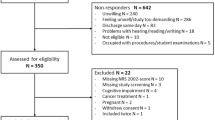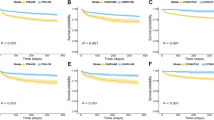Abstract
BACKGROUND/OBJECTIVES:
Malnutrition risk and its consequences have not been reported in obese and overweight newly hospitalized patients. To estimate malnutrition risk among newly hospitalized overweight or obese patients, and to assess the effect of body mass index (BMI) on duration of hospitalization and risk of in-hospital death among hospitalized adults at increased risk of malnutrition.
SUBJECTS/METHODS:
In this survey, all adults newly admitted to internal medicine and surgical departments at a large tertiary medical center, during the 5-week data acquisition period in 2010, were screened for malnutrition risk using the Nutrition Risk Screen (NRS 2002). Malnutrition risk was compared across body weight categories. In addition, overweight/obese subjects were compared by malnutrition risk category.
RESULTS:
Of the 431 individuals analyzed, 138 were overweight and 105 were obese. Among overweight or obese patients, 23.2% and 24.8%, respectively, were at increased risk for malnutrition. Elevated risk for malnutrition prolonged hospitalization for both overweight and obese patients (from 5.6±7.9 to 10.0±10.3 days (P=0.04) and from 4.8±4.6 to 15.1±25.7 days (P=0.001), respectively). Prolonged hospital stay remained associated with malnutrition risk after controlling for age and BMI. Malnutrition risk significantly increased odds of in-hospital death: odds ratio (OR) 6.4, 95% confidence interval (CI) 1.2–33.2, P=0.03, even after controlling for age and BMI.
CONCLUSIONS:
Increased malnutrition risk is a frequent finding in newly hospitalized overweight/obese adults, prolongs length of hospital stay and increases risk of in-hospital mortality.
This is a preview of subscription content, access via your institution
Access options
Subscribe to this journal
Receive 12 print issues and online access
$259.00 per year
only $21.58 per issue
Buy this article
- Purchase on Springer Link
- Instant access to full article PDF
Prices may be subject to local taxes which are calculated during checkout


Similar content being viewed by others
References
Saunders J, Smith T . Malnutrition: causes and consequences. Clin Med 2010; 10: 624–627.
Ramakrishnan U . Prevalence of micronutrient malnutrition worldwide. Nutr Rev 2002; 60: S46–S52.
Correia MI, Campos AC . Prevalence of hospital malnutrition in Latin America: the multicenter ELAN study. Nutrition 2003; 19: 823–825.
Beghetto MG, Luft VC, Mello ED, Polanczyk CA . Accuracy of nutritional assessment tools for predicting adverse hospital outcomes. Nutr Hosp 2009; 24: 56–62.
Gyres S, Leibovitz E, Matas Z, Fridman S, Gavish D, Shalev B et al. Measuring nutrition risk in hospitalized patients: MENU, a hospital-based prevalence survey. Isr Med Assoc J 2012; 14: 405–409.
Rüfenacht U, Rühlin M, Wegmann M, Imoberdorf R, Ballmer PE . Nutritional counseling improves quality of life and nutrient intake in hospitalized undernourished patients. Nutrition 2010; 26: 53–60.
Goiburu ME, Goiburu MMJ, Bianco H, Díaz JR, Alderete F, Palacios MC et al. The impact of malnutrition on morbidity, mortality and length of hospital stay in trauma patients. Nutr Hosp 2006; 21: 604–610.
Lawson RM, Doshi MK, Barton JR, Cobden I . The effect of unselected post-operative nutritional supplementation on nutritional status and clinical outcome of orthopaedic patients. Clin Nutr 2003; 22: 39–46.
Rasmussen HH, Holst M, Kondrup J . Measuring nutrition risk in hospitals. Clin Epidemiol 2010; 2: 209–216.
Song X, Pitkäniemi J, Gao W, Heine RJ, Pyörälä K, Söderberg S et al. Relationship between body mass index and mortality among Europeans. Eur J Clin Nutr 2011; 66: 156–165.
Boggs DA, Rosenberg L, Cozier YC, Wise LA, Coogan PF, Ruiz-Narvaez EA et al. General and abdominal obesity and risk of death among black women. N Engl J Med 2011; 365: 901–908.
Evans DC, Stawicki SP, Davido HT, Eiferman D . Obesity in trauma patients: correlations of body mass index with outcomes, injury patterns, and complications. Am Surg 2011; 77: 1003–1008.
Gupta R, Knobel D, Gunabushanam V, Agaba E, Ritter G, Marini C et al. The effect of low body mass index on outcome in critically ill surgical patients. Nutr Clin Pract 2011; 26: 593–597.
Hutagalung R, Marques J, Kobylka K, Zeidan M, Kabisch B, Brunkhorst F et al. The obesity paradox in surgical intensive care unit patients. Intens Care Med 2011; 37: 1793–1799.
Weiss A, Beloosesky Y, Boaz M, Yalov A, Kornowski R, Grossman E . Body mass index is inversely related to mortality in elderly subjects. J Gen Intern Med 2008; 23: 19–24.
Weiss A, Boaz M, Beloosesky Y, Kornowski R, Grossman E . Body mass index and risk of all-cause and cardiovascular mortality in hospitalized elderly patients with diabetes mellitus. Diabet Med 2009; 26: 253–259.
Kondrup J, Rasmussen HH, Hamberg O, Stanga Z . Nutritional risk screening (NRS 2002): a new method based on an analysis of controlled clinical trials. Clin Nutr 2003; 22: 321–336.
Friedwald WT, Levy RT, Fredrickson DS . Estimation of the concentration of low-density lipoprotein-cholesterol without the use of the preparation ultracentrifuge. Clin Chem 1972; 18: 499–502.
Hickson M, Frost G . A comparison of three methods for estimating height in the acutely ill elderly population. J Hum Nutr Diet 2003; 16: 13–20.
Jung MY, Chan MS, Chow VSF, Chan YTT, Leung PF, Leung EMF et al. Estimating geriatric patient’s body weight using the knee height caliper and mid-arm circumference in Hong Kong Chinese. Asia Pac J Clin Nutr 2004; 13: 261–264.
Kaidar-Person O, Person B, Szomstein S, Rosenthal RJ . Nutritional deficiencies in morbidly obese patients: a new form of malnutrition? Part A: vitamins. Obes Surg 2008; 18: 870–876.
Kaidar-Person O, Rosenthal RJ . Malnutrition in morbidly obese patients: fact or fiction? Miner Chir 2009; 64: 297–302.
Brody H, Hermer LD, Scott LD, Grumbles LL, Kutac JE, McCammon SD . Artificial nutrition and hydration: the evolution of ethics, evidence, and policy. J Gen Intern Med 2011; 26: 1053–1058.
Author information
Authors and Affiliations
Corresponding author
Ethics declarations
Competing interests
The authors declare no conflict of interest.
Rights and permissions
About this article
Cite this article
Leibovitz, E., Giryes, S., Makhline, R. et al. Malnutrition risk in newly hospitalized overweight and obese individuals: Mr NOI. Eur J Clin Nutr 67, 620–624 (2013). https://doi.org/10.1038/ejcn.2013.45
Received:
Revised:
Accepted:
Published:
Issue Date:
DOI: https://doi.org/10.1038/ejcn.2013.45
Keywords
This article is cited by
-
Association between body mass index and newly diagnosed drug-resistant pulmonary tuberculosis in Shandong, China from 2004 to 2019
BMC Pulmonary Medicine (2021)
-
Malnutrition screening on hospital admission: impact of overweight and obesity on comparative performance of MUST and PG-SGA SF
European Journal of Clinical Nutrition (2021)
-
Double burden of malnutrition in persons with obesity
Reviews in Endocrine and Metabolic Disorders (2020)



